Sapa Travel Guide To Explore the Beauty of Northern Vietnam
Sapa is famous for its spectacular rice terraces, vibrant local culture, and misty mountain scenery. Any comprehensive Sapa travel guide will highlight why this destination attracts visitors seeking adventure, natural beauty, and cultural immersion. Sapa caters to everyone's needs, whether you enjoy outdoor activities or want to learn about the customs of diverse ethnic groups.
Discover why this hidden gem should top your Vietnam travel bucket list!
How To Get To Sapa?
Since there is no airport in Sapa where direct flights are available, travelers typically begin their journey in Hanoi. About 300 kilometers separate Hanoi from Sapa, and there are several ways to get there, including by bus, train, or private vehicle.
Hanoi to Sapa sleeper bus
The bus from Hanoi to Sapa is the cheapest option, and sleeper buses from Hanoi to Sapa are becoming increasingly popular with tourists. The bus journey from Hanoi to Sapa takes around 5 to 6 hours.
Trains to Hanoi
Most tourists will choose the train from Hanoi to Sapa because it is safe, comfortable, convenient, and time-saving. The journey takes approximately 8 to 9 hours. A shuttle bus takes one hour to go to Sapa town from Lao Cai Station.
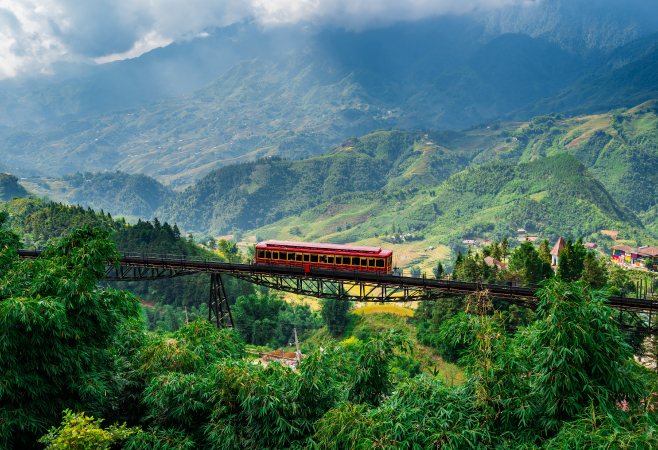
The Hanoi to Sapa train is a popular option for visitors to Sapa
Whichever route you choose, your trip to Sapa will always be surrounded by breathtaking scenery and unforgettable adventure in this breathtaking mountain region.
When Is The Best Time To Visit Sapa Vietnam?
The best time to visit Sapa is during the shoulder seasons of March to May and September to November.
Spring brings lush vegetation, blooming flowers, and pleasant temperatures. However, fall brings golden rice fields and milder temperatures. Hiking in summer is not ideal due to heavy rainfall and colorful landscapes. Winter can be quiet, cold, and occasionally snowy.
Best Things To Do in Sapa For Unforgettable Vacation
1. Trekking
Trekking is one of the things that visitors to Sapa must undertake, and a trekking tour of Sapa is the perfect way to explore this stunning region. This area is a delight for hiking enthusiasts due to its majestic natural beauty. Popular trails include:
Cat Cat Village: Just a short walk from Sapa town, this village is home to the Hmong people. It offers stunning views and cultural insight.
Lao Chai and Ta Van Villages: These villages are part of the Muong Hoa Valley and offer visitors an immersive experience of local life.
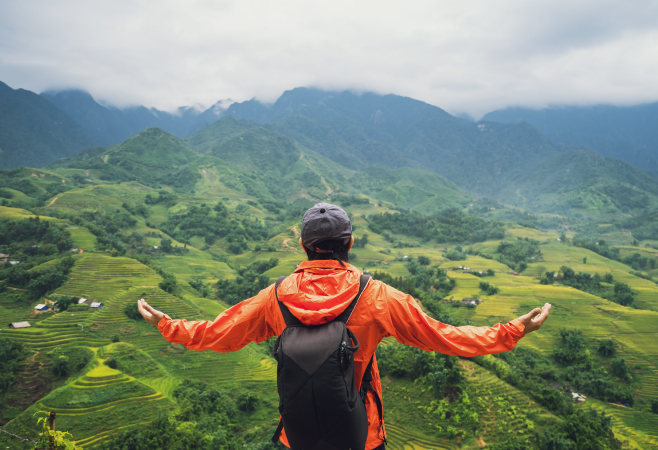
Trekking is one of the things that visitors to Sapa must undertake
2. Experience local cuisine
A trip to Sapa wouldn't be complete without sampling some local delicacies! Sapa cuisine is made from fresh, natural ingredients from the mountains, skillfully combining the flavors of many ethnic traditions.
Don't forget to try some of Sa Pa's most famous dishes such as Five-color sticky rice, Salmon hotpot, Grilled buffalo gac fruit, Thang co and Cat apple wine.
3. View the terraced rice fields
A great experience when visiting Sa Pa is to see the terraced rice fields in Sa Pa, an important aspect of tourism in Sapa. These famous fields look like a series of undulating steps reaching up to the sky and coincidentally have been tended by local ethnic minority groups for centuries.
Each season has its own charm: the fields glisten in the water in spring, reflecting the brilliant colors of the sky. In summer, they are filled with green as the rice plants bloom. And in autumn, they turn a golden yellow, ready for harvest.

Viewing Sapa's terraced rice fields is a key tourism highlight
4. Visit minority villages
The villages in Sapa are a must-see for anyone creating a "things to do in Sapa" itinerary. Cat Cat Village, Ta Van Village, Ta Phin Village, Lao Chai Village, Ban Ho Village, Sin Chai Village, Sau Chua Village, and Hang Da Village are among the most popular spots to visit.
These towns offer a great opportunity to explore the diverse customs of some of Vietnam's ethnic minority groups. All set against the breathtaking backdrop of Sapa's rugged mountains. With each village having its own distinct charm and customs, your visit will truly be a cultural experience!
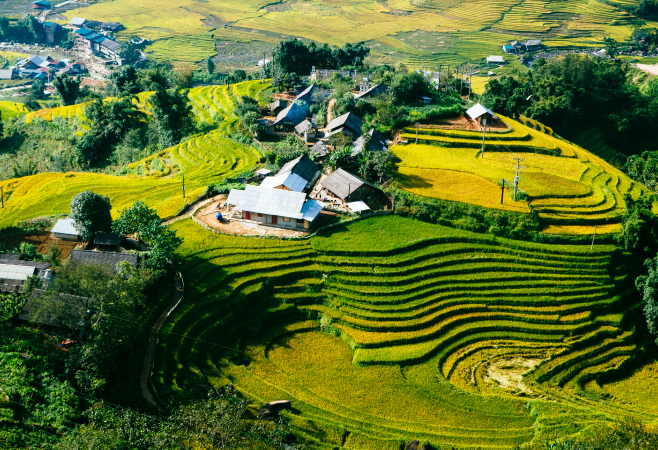
Sapa's villages are a must-see for anything to do in the Sapa itinerary
5. Experience Fansipan mountain
Fansipan is the highest mountain in Vietnam, and for that reason, it is also the biggest highlight of Sapa attractions. Experiencing Fansipan Mountain is an unforgettable adventure, offering breathtaking views and a sense of accomplishment.
As the highest peak in Vietnam, Sapa Fansipan can be reached in two ways: by hiking or by cable car. For those looking for a challenge, this hike will take you through lush forests and stunning scenery. Hiking this route usually takes two to three days. As an alternative, the cable car provides a short and picturesque ascent from which you can take in breathtaking views of the surrounding valleys and mountains in as little as fifteen minutes.
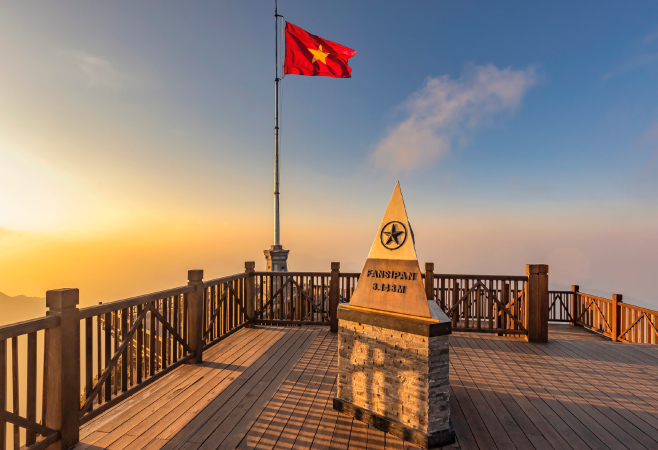
Fansipan is the highest mountain in Vietnam
6. Walk across the glass bridge
The glass bridge excursion is a good option if you're not sure what to do in Sapa at night. Because the bridge's surface is 60 meters from the mountain wall, it appears as though it is hovering in midair.
You might get a little "butterflies in the stomach" when you stand on the glass bridge and gaze down to the vast bottom. At the same time, though, you will experience awe and delight as you look off into the distance and take in the magnificent views of Vietnam's most striking "Four Great Passes."
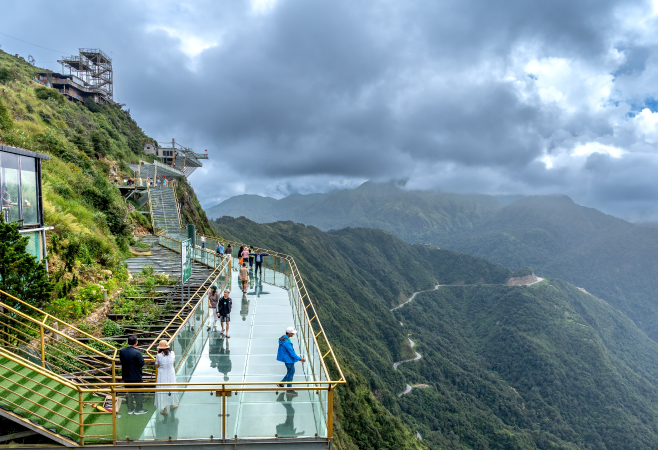
The glass bridge excursion is a great option for Sapa nightlife
7. Go shopping for local crafts
Unique goods and gifts can be found at the many local markets in Sapa and the surrounding districts. Many of the small shops in these markets display handicrafts such as leather wallets, musical instruments, and items made by the locals themselves.
Be sure to visit the quaint markets in the smaller villages for a truly authentic shopping experience. In addition to finding exquisitely crafted items at affordable prices, you will also have the opportunity to interact with the talented craftsmen who make these items.
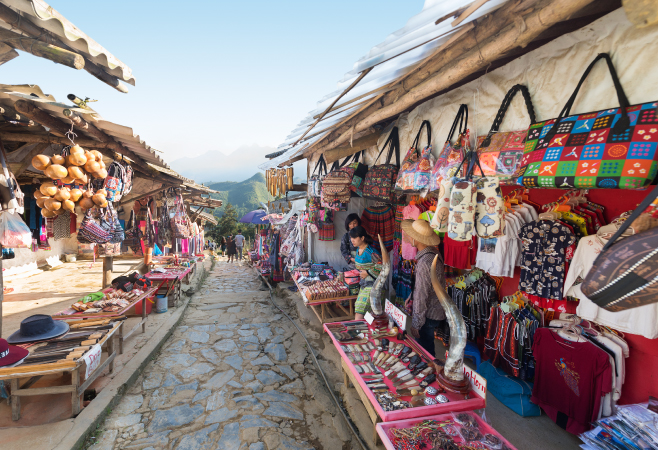
Unique goods and presents can be found in the many local markets in Sapa
What Do You Need To Know For The First Time To Sapa?
Sapa with kids
Sapa is a great place to take children. You can decide to hike with your children for half a day, full day, or multiple days, depending on their age and stamina. Additionally, it is a fantastic resource for learning about the traditions of numerous ethnic minorities. Taking the cable car to Fansipan is an additional choice.
Language
Due to Sapa's thriving tourism sector, numerous staff members in restaurants and hotels speak English fluently. Foreign tourists are encouraged to accompany a tour guide to facilitate their visits to the local villages.
What to bring
When traveling to Sapa, it's advisable to pack for all weather conditions because the weather might change drastically throughout the day. An extensive Sapa guide can offer recommendations for what to pack:
- Clothes: Because Sapa evenings may get fairly cold, it's a good idea to bring at least one item to stay warm, regardless of the season.
- Comfortable Shoes: Ideal for trekking and village exploration, especially as the villages are spread out across hilly terrain.
- Sun Protection: Sunscreen, sunglasses, and a hat for sunny days as well as when visiting the summit of Fansipan.
- Insect Repellent: A must for nature-based outdoor activities.
- Cash: It’s advisable to carry some cash, as changing money can be challenging in Sapa.
- Medication: Don't forget to pack all of your prescription drugs if you have any personal health issues.
Where to stay in Sapa?
Travelers visiting Sapa can choose from a range of lodging alternatives, including budget hotels, hostels, guesthouses, and homestays in ethnic villages. For a more luxurious stay, options include five-star hotels and remote resorts.
To have a true Sapa experience, many visitors choose homestays or hostels. You can stay in charming homestays in places like Cat Cat, Lao Chai, and Ta Van to experience the tranquil mountain surroundings.
Hotels in Sapa range in price according to the type of accommodation. While dorm beds typically start at 100,000 VND per night, a double room can cost up to 500,000 VND one night. If guests choose a more luxurious stay, there are high-end resorts and hotels with nightly rates starting at 2,000,000 VND.
With breathtaking scenery, rich cultural heritage and endless opportunities for adventure, Sapa promises an unforgettable travel experience for anyone planning a trip to Vietnam vacation. Whether you are trekking through rice terraces, exploring local villages or simply soaking in the stunning scenery, Sapa is a destination that will leave you spellbound long after your trip.
So pack your bags, apply for your visa, and get ready to explore this beautiful corner of Vietnam!
Related Articles
- Custom In Vietnam: A deep dive into Vietnamese traditions
- Retire in Vietnam: The ultimate guide for a dream retirement
- Trang An, Vietnam: A journey through Vietnam's natural wonder
- Vietnam Metro: The future of urban transportation in Vietnam
- Main districts of Ho Chi Minh city: Iconic landmarks & travel map
HOW CAN WE HELP?
APPLY WITH CONFIDENCE










